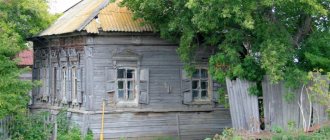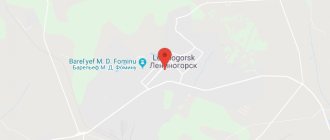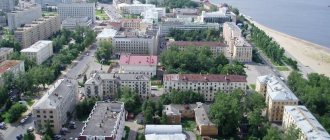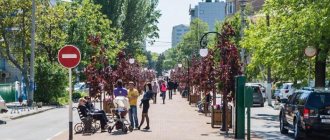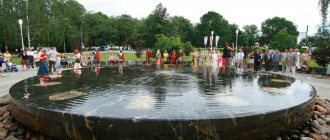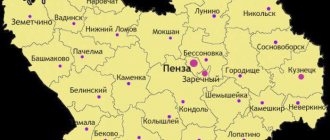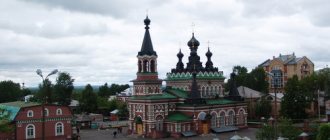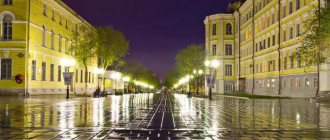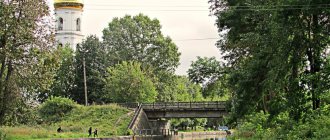Key information
The total length of the borders exceeds 1,100 kilometers. About half are in Ukraine. The area of the region is 27,000 km². The distance between the eastern and western parts of the region exceeds 270 km, and between the southern and northern parts it is about 190 km. Weather conditions have the features of a temperate continental climate. The coldest month is January. The frost-free period is 160 days.
The history of the Belgorod region begins in the 8th century. This is evidenced by artifacts that were found during archaeological excavations. The region belonged to the Khazars, Kievan Rus, Mongol-Tatars, and the Grand Duchy of Lithuania. In the 16th century, the Belgorod region became part of the Moscow Principality.
Residents
The population of the Belgorod region exceeds 1,500,000 people. Urban residents account for 67%. All the rest are employed in agriculture. The demographic situation in the region compared to the neighboring subjects of the Federation allows us to make favorable forecasts. The number of its inhabitants is growing steadily. The population density of the Belgorod region exceeded 57 people per square kilometer.
Historical reference
In 1959, the number of Belgorod residents barely reached 1,220,000 people. Moreover, city residents accounted for only 20%. In 1970, 1,261,000 were registered in the region. The share of peasants was still high and amounted to 65%. In 1979, the population of the Belgorod region exceeded 1,300,000. The number of city residents increased, it reached 53%.
In 1989, 1,380,000 people lived in the region. In 2002, according to statistics, 1,511,000. The number of city residents continued to increase rapidly and reached 65%. In 2010, the total number of Belgorod residents exceeded 1,530,000.
Population of Gubkin for 2022 and 2022. Number of residents of Gubkin
Data on the number of city residents are taken from the Federal State Statistics Service. The official website of the Rosstat service is www.gks.ru. The data was also taken from the unified interdepartmental information and statistical system, the official website of EMISS www.fedstat.ru. The website publishes data on the number of residents of Gubkin. The table shows the distribution of the number of Gubkin residents by year; the graph below shows the demographic trend in different years.
Links to official documents and resources on the population census are marked with a [*] sign; when you hover your mouse, you will see the title of the document.
| Number of residents of Gubkin | Years |
| 86,200 people | 2006 |
| 86,300 people | 2007 |
| 86,400 people | 2008 |
| 86,554 people | year 2009 |
| 88,560 people | 2010 |
| 88,600 people | 2011 |
| 88,106 people | year 2012 |
| 87,556 people | year 2013 |
| 87,896 people | year 2014 |
| 87,405 people | 2015 |
| 87,083 people | 2016 |
| 86,999 people | 2017 |
Graph of population changes in Gubkin:
The total population in 2015 was approximately 87.4 thousand people. Density - 2758 people/km².
Representatives of such nationalities as Russians, Ukrainians and others live in the city
Ethnic burial: Gubkinets, Gubkintsy.
National composition
The dominant ethnic group in the region are Russians. Their numbers almost always exceeded 90%. The ethnic composition of the population of the Belgorod region is diverse. In addition to Russians, Ukrainians, Armenians, Turks and Azerbaijanis live in the region. Their number varies. At the moment, there is a tendency to actively increase the number of representatives of the Ukrainian diaspora. The share of other ethnic groups is insignificant and does not exceed 1%.
Map of the city of Gubkin. Gubkin Yandex maps
Created using the Yandex service People's Map (Yandex map), when zoomed out you can understand the location of Gubkin on the map of Russia. Gubkin Yandex maps. Interactive Yandex map of the city of Gubkin with street names, as well as house numbers. The map has all the Gubkin symbols, it is convenient and not difficult to use.
On the page you can read some descriptions of Gubkin. You can also see the location of the city of Gubkin on the Yandex map. Detailed with descriptions and labels of all city objects.
Share information with friends:
Settlement
The list of the largest cities in the Belgorod region is headed by Belgorod. Its municipal district of the same name is considered the most densely populated. Its area is 153 km², and the number of residents exceeds 391,000. The second largest urban district is Starooskolsky. It is home to 259,986 people. Gubkinsky municipality occupies third position. It is experiencing a natural population decline. The number of citizens is less than 120,000.
There are nineteen districts in the area of the Belgorod region. Alekseevsky has a population of 61,000 people. In Belgorodsky 116,000, in Borisovsky 25,000. The population of the Belgorod region in the Valuysky district is 67,000, and in Korochansky 39,000.
List of municipal districts in which natural decline has been recorded:
- Veidelevsky (19,000);
- Volokonovsky (30,000);
- Grayvoronsky (30,000);
- Ivnyansky (22,000);
- Krasnensky (12,000);
- Krasnogvardeisky (37,000);
- Novooskolsky (41,000);
- Chernyansky (31,000);
- Shebekinsky (90,000).
The number of residents is steadily increasing in the following areas:
- Yakovlevsky (57,000);
- Rovensky (23,000);
- Rakityansky (35,000);
- Krasnoyaruzhsky (15,000).
In the Prokhorovsky municipal district, the number of deaths is equal to the number of newborns.
The most prosperous settlements in the region, from a demographic point of view, are:
- Belgorod;
- Stary Oskol;
- Valuyki;
- Builder;
- Reasonable;
- Rovenki;
- Northern;
- Veidelevka;
- Tomarovka;
- Streletskoe;
- Krasnaya Yaruga;
- Oak;
- May;
- Prokhorovka;
- Bessonovka;
- Pushkarnoye;
- Livenka;
- Sucking;
- Tavrovo;
- New Tavolzhanka;
- Maslova Pier.
List of cities in the Belgorod region whose population shows a natural decline:
- Gubkin;
- Shebekino;
- Alekseevka;
- Novy Oskol;
- Chernyanka;
- Borisovka;
- Volokonovka;
- Grayvoron;
- October;
- Biryuch;
- Urazovo;
- Willow;
- Proletarian;
- Rakitnoe;
- Horny;
- Bekhteevka;
- Skorodnoe;
- Pyatnitskoe;
- Golovchino;
- In short.
City Day 2018: how we will celebrate the 79th anniversary of Gubkin
Although every year we have City Day, in general, according to one scenario, nevertheless, on its eve, the most popular search query in search engines is “Poster of festive events”. Gubkin residents are waiting for a holiday, waiting for variety and quite familiar things. Well, let's see what will surprise us this time and whether we will be surprised...
8 September
At 9 am, the Golden Autumn fair will open its doors at the central market. It is there that the largest pumpkin will be chosen, and the pumpkin festival will become part of the fair.
The success of pumpkin growers will be assessed in four categories:
- "Giant Pumpkin"
- "Pumpkin Delight"
- "Pumpkin's Tale"
- "Merry Pumpkin."
And at 10 am a flower extravaganza will unfold on Lenin Square. We are invited to an exhibition-vernissage, whose name has not changed for several years, “Theater of Flowers – the Color of Emotions.” Dozens of teams, organizations and enterprises will present their work (many incredibly interesting), so come, there will be something to see.
September 14
The Forum Center is waiting for poetry lovers. At 14.00 there will be a presentation of Galina Rebrova’s collection of poems “With Love About Love”.
September 15th
Next Saturday microdistrict. Swans celebrate their birthday. On this occasion, on the square from 13.00 at the Lebedinets Central Cultural Centre, a large cultural and entertainment program is planned with mandatory awards for the most active residents of the microdistrict, musical gifts, exhibitions, competitions and other things.
On the same day, the Gubkin Theater invites young spectators to the premiere performance “Cat's House”. Starts at 16.00.
September 22nd
Now we have reached the most important day. It is on the 22nd that the culmination of the celebration of the 79th anniversary of Gubkin is expected, which will end with a fireworks display.
As usual, to participate in the festive procession, people will begin to gather on the streets at 9 am
. But the city fathers will start the demonstration itself at 10 am.
When the march of the groups through the square is over, the action will move to the park on Sovetskaya Street, where rural farmsteads will unfold. At the art festival “Gubkin Karagod for the anniversary of the Belgorod region” you will be able to enjoy delicious pancakes, stock up on honey for the winter, listen to ditties, and buy some crafts from craftswomen as souvenirs. It’s not for nothing that Gubkin residents love Karagod so much.
Lebedinsky Express: Karagod in Gubkin style 2017.
And in 12.00
On the stage of the Forum Central Cultural Centre, a solemn meeting “I read the city like a book” will take place.
IN 13.00
vocal fans will gather in the central square. The winners and participants of the pop song competition “Starry Rain” will perform for them.
IN 17.00
The children's holiday “Give Sunshine to Childhood” will begin.
18.00
– dance program accompanied by a brass band.
19.00
- Gala Concert.
21.00
- festive fireworks.
21.15
– dance program for youth.
From 14 to 30 September
In the exhibition hall of the Forum, an exhibition of children’s drawings “City Life” will be open for Gubkin guests.
September 18
The exhibition “Colors of Autumn” will open at the local history museum.
September 20
And from this day on, the same local history museum invites you to an exhibition of works by the children's art school teacher N. Sokolova.
...In general, I can’t say that there will be something outstanding, going beyond the usual events. Let's hope that energy is thrown into the future 80th anniversary of the city and next year the scope of the holiday and its “components” will amaze the imagination. In the meantime, let's be happy with what we have.
Economic situation
The Belgorod region is recognized as a developed subject of the Federation. It has not only an agricultural, but also an industrial sector. The latter is represented by mechanical engineering, production of building materials, mining of raw materials, metallurgical enterprises, and food factories.
The standard of living of the population of the Belgorod region is considered one of the highest in the Central Federal District. The leading industrial enterprises in the region are Lebedinsky and Stoilensky mining and processing plants, Oskolplast, Belgorod Cement, Stroymetallkom. Economists single out the group, OJSC SUM TsMM. The Oskol Metallurgical Engineering Plant is actively developing. The management of the Oskol Electrometallurgical Plant achieved excellent results.
Agricultural land makes up 70% of the area of the Belgorod region. These are fertile black soils. Today the region tops the list of leaders in the production of poultry, pork, dairy products and grains in Russia. The unemployment rate is minimal. The employment rate is approaching 90%.
Gubkin, a city in the Belgorod region
Gubkin, a city (since 1955) in the Belgorod region.
90 thousand inhabitants (2001). Iron ore mining. The mining capital of the Black Earth Region, its history is connected with the development of the region of the Kursk magnetic anomaly. The first evidence of Kursk iron ores dates back to the beginning of the 18th century. On September 30, 1931, the first exploration and production mine of KMA was founded. On September 19, 1939, the settlement at the KMA mine was classified as a workers' settlement and named Gubkin. In May 1953, an enterprise for the extraction and processing of iron ore, the KMAruda plant, was created. An important stage in the development of the city was the construction of the Lebedinsky quarry, where open-pit mining of iron ore began for the first time in the USSR. Gubkin is a major scientific and cultural center of the Belgorod region. The city of Gubkin has been a sister city of Dzerzhinsky since 2001.
Prepared by L.A. Gavrilova SES. M. "Soviet Encyclopedia". 1985
Gubkin city
Coat of arms of the city of Gubkin
By historical standards, the city of Gubkin is still very young; in 2010 it celebrated its 71st anniversary of its formation. It owes its appearance to the discovery of the richest iron ore deposits in the Kursk magnetic anomaly. Gubkin is rightly called the pearl of the KMA, its mining capital, because the history of the city cannot be separated from the history of the development of the entire Kursk-Belgorod iron ore basin.
In September 1931, the first exploration and exploitation mine of KMA was founded, and a settlement grew nearby, which in 1939, by Decree of the Presidium of the Supreme Council of the RSFSR, was classified as a workers' settlement and named in honor of Academician I.M. Gubkin, who led exploration work for 19 years in the KMA basin. The day the Decree was issued (September 19) is considered to be the city’s birthday.
The Great Patriotic War prevented further industrial development of the deposits. Purely peaceful people became soldiers. About 1,900 people from the young workers' village went to the front, and in total, almost 16,000 people from the region joined the ranks of the defenders of the Motherland, of whom 9,685 did not return from the battlefields. After the liberation, the village named after Gubkin presented a bleak picture. All buildings were destroyed almost to the ground, the mine was flooded, and most of the industrial and mining equipment was rendered completely unusable. But the most valuable thing remains - people’s faith in the speedy development of the KMA’s wealth.
Large-scale development of the KMA resources began in the 50s of the last century. In May 1953, on the basis of the KMA mine and two factories, the region’s first enterprise for the extraction and processing of iron ore, the KMA-ore plant, was created. Its formation and development contributed to the fact that on the site of a workers’ village a young mining town grew up, which, by the Decree of the Presidium of the Supreme Soviet of the RSFSR of December 23, 1955, was classified as a city of regional subordination.
An important stage in its development was the construction of the Lebedinsky mine, where open-pit mining of iron ore began for the first time in the Soviet Union. Its construction was declared an All-Union Komsomol construction project, and over 5 thousand young men and women came to the young city on vouchers. The city grew at a rapid pace. On March 7, 1960, by Decree of the Presidium of the Supreme Soviet of the RSFSR, Gubkin became a city of regional subordination.
The rapid growth of mining production and a significant increase in the urban population led to the restructuring of agriculture, its concentration and specialization. In 1965, the Gubkinsky district was formed, in which in subsequent years a lot of work was carried out on the construction of new agricultural complexes and processing enterprises. In the 70s, the Lebedinsky Mining and Processing Plant was built, which was subsequently listed twice in the Guinness Book of Records: as an enterprise developing a unique iron ore deposit (more than 20 billion tons) and having the world's largest quarry for the extraction of non-combustible minerals.
Palace of Culture "Forum"
Gubkin today is a modern beautiful city, one of the industrial centers of the Belgorod region with rich cultural and spiritual traditions and developed infrastructure. It is the administrative center of the Gubkinsky urban district, the total area of which is 152,662 hectares. Population – 120 thousand people. The basis of the territory's economy, along with the mining complex, is formed by such dynamically developing industries as construction, transport, communications, processing industry and agricultural enterprises.
Lazarev Square
Gubkin residents are rightfully proud of their clean, beautiful streets and squares, and landscaped neighborhood areas. This experience in the comprehensive improvement of the city and rural settlements, the construction of social and cultural facilities is widely studied and disseminated in the Belgorod region and beyond. Delegations from many cities of the Central Federal District and other regions of the Russian Federation come to get acquainted with the achievements of Gubkin residents.
Local governments carry out extensive and targeted work to improve the quality of life of the population. New socially significant facilities are put into operation every year. Over the past 14 years, 136 social and cultural facilities have been built and overhauled. These are hospitals, schools, houses of culture, sports facilities, buildings of various institutions, Orthodox churches. Many of them have no analogues in Russia in terms of the designs used during construction and reconstruction, the technologies used, modern materials and structures, and the level of equipment.
Transfiguration Cathedral. One of the largest newly built cathedrals in Russia.
“People must live with dignity,” is the main principle of the activities of the head of the administration of the Gubkinsky urban district, Anatoly Alekseevich Kretov. Fruitful work in all areas of the regional Program for improving the quality of life of the population, the creation of an effective system of local self-government bodies confirms that the leadership of the territory, through the comprehensive use of internal resources and constructive interaction with federal and regional authorities, is pursuing an effective socio-economic policy in the municipality, which contributes to the successful implementation of priority national projects and allows us to move forward towards improving the well-being of Gubkin residents.
New surgical building of the Central District Hospital
Successes in the socio-economic development and improvement of the city have been repeatedly awarded with various awards. Gubkin took second place in the All-Russian competition for the title “The Most Comfortable City in Russia” for two years in a row, and in 2003 became the winner of the competition in its category. In 2001, the “Best Managers of the New Era” Foundation awarded the “Face of Russia” diploma for high socio-economic indicators and exceptional achievements in the field of improvement, and awarded the territorial administration with a special prize in the nomination “For effective management and successful solution of the city’s socio-economic problems.” . In 2002, the city of Gubkin received a certificate from the All-Russian Golden Ruble competition. According to the results of the 2007 rating competition among the municipalities of the region, the Gubkinsky City District took first place in overall results in the development of the economy and social sphere and was included in the regional Walk of Labor Glory.
The article was presented by L.Yu. Maltseva November 10, 2010.
Find out more about the city here www.gubkinadm.ru
Fertility
In the cities of the Belgorod region in 2000, there was a tendency to increase the child population. The birth rate has doubled over the past ten years. Every year this figure increases by approximately 0.3%. The region is one of the three subjects of the Federation in terms of the number of babies born. It occupies third position, behind the Bryansk, Tver and Kostroma regions.
According to analysts, the birth rate is directly related to the quality of life and the availability of social services. Today there are 130,000 women of childbearing age in the region. The dynamics of the increase in the number of children is explained by the increase in the number of rebirths. At the same time, the number of first-born children decreased noticeably, reaching 56.2%. The share of third children is 7.3%. The number of fourth and fifth children has decreased slightly.
Every year, every twentieth resident of the Belgorod region becomes pregnant. At the same time, the trend towards an increase in the number of pregnancies among mature women continues. In the group from 35 to 39 years old, the birth rate is 6%. The category from 30 to 34 years old accounts for 18%. The maximum is observed in women over 25, but under 29.
The average age of a woman giving birth is 28 years. For reference, in 1990 this parameter did not exceed 24. There are an average of 1.4 births per woman aged 15 to 49 years.
Guide “Gubkin: from the village of Korobkovo to the present day”
Krylova Y.V., Pashkova N.V., MBUDO “Station for young tourists”
The historical core of the city of Gubkin can be called the territory of the former Korobkov estate. This is the oldest building in the city. In 1787, construction of a manor house began here according to the design of the architect A.A. Vorobyov. At first it was one-story, wooden, and was later replaced in 1830 by brick. Due to the growth of the family, a second and third floor with a veranda were added. The estate with a stone first and wooden second and third floors was built in a classical style. Throughout the 20th century, the manor buildings were used in different ways and were gradually destroyed. Only the residential building and stables have survived to this day. The house housed a school from 1936 to 1970, and a hospital during the war years. In 1970-1989 a music school was located here. Since 1993, the building was adapted for the Church of the Apostle James; in 2005, it was given over to a spiritual Orthodox center for children.
No less remarkable were the landowner's garden and park with an area of 13 hectares. Benches, greenhouses, and gazebos were hidden in the shady alleys of maple, oak, and birch; the paths were covered with sand. There were 2 ponds in the garden - in one they swam, in the other they raised fish. The garden was surrounded by a brick fence, which was dismantled after the war to build housing. In the summer of 1943, most of the garden was uprooted during the construction of the Stary Oskol - Sarajevo railway. Five hundred-year-old trees in the park have survived to this day: linden, maple, pine, oak, and elm. Currently, the park is landscaped and is one of the favorite recreational places for city residents.
The center of the Gubkin mining village was located on the territory of a former manorial estate. The Korobkovsky stables were reconstructed, the middle part of the building was raised by three floors, and the left and right ones by two. The KMAstroy management office was located in the house of the landowner Korobkov. On the territory of the estate along the pond, Sportivnaya Street was built with two-apartment brick houses, which was later renamed Skvortsova Street.
Now on this site there is a park named after N.M. Shumeiko and the Temple of the Apostle James, Brother of God and Holy Blessed Prince Alexander Nevsky. And in 2022, on the eve of Miner’s Day, a monument to N.M. Shumeiko with a height of 2.06 meters was erected here near the territory of the household where he lived. The name of Nikolai Mikhailovich Shumeiko was given to the park on Skvortsov Street on May 9, 2011. N. M. Shumeiko - mining engineer, head of the Lebedinsky mine, Honorary Citizen of Gubkin and the Gubkinsky district, pioneer of the KMA, first head of the Gubkin mine... The name of Nikolai Mikhailovich is inextricably linked with the history of the development of the Kursk magnetic anomaly, with the history of our city...
On the territory of the Korobkov estates there were many forested lands, unplowed fields and meadows, which contributed to the breeding of livestock, especially horses, which were sold in the markets of Kharkov, Voronezh, Kursk, Moscow, St. Petersburg and even abroad. Especially famous were the Korobkovsky trotters of the Oryol breed and the thoroughbred heavy draft horses imported for breeding from Germany.
The stable, designed for 500 horses, aroused the envy of guests with its architecture. An excellent arena was built for the horses.
The horse yard has firmly entered the history of our city, since it was in this building that healthcare, education and culture, trade, consumer services began their development, and law enforcement agencies were born.
In the 70-90s, this part of the building housed the Yubileiny department store, then Komissiyny, Proviant, and since 2013 the building was overhauled and reconstructed into a modern multifunctional center for the provision of state and municipal services (MFC).
Walking along Pobeda Street, you can see the very first preschool institution in our city - the Skazka kindergarten.
On the pre-May holidays of 1964, a bust of Academician Ivan Mikhailovich Gubkin was erected on Lenin Square. The monument was opened by the Chairman of the City Council V.I. Ovsyannikov. In connection with the installation of a monument to the leader on Lenin Square in 1970, who celebrated the 100th anniversary of his birth, the monument to academician I.M. Gubkin was moved to Pobeda Street and installed in the park located between the district executive committee and the Yubileiny store (since 2013 "MFC").
On September 9, 1977, a monument to Georgy Mikhailovich Dimitrov was erected on Tchaikovsky Street. (G.M. Dimitrov is a leader of the Bulgarian and international communist movement). The monument was erected in the children's park opposite the 40 Let Oktyabrya cinema. Tchaikovsky Street was renamed Dimitrov Street.
During the reconstruction of the square in 2000, it was demolished, and Dimitrov Street was returned to its original name - Tchaikovsky.
In 2015, at the beginning of the Children's Square (the place where the monument to G.M. Dimitrov was located), an unusual forged sculptural composition “Don Quixote of La Mancha” appeared. It was made by talented welders A.E. Yakovlev and V.N. Chernykh. This is a kind of surprise for the townspeople, provided by the Gubkin Heating Company (CHP).
In 1969, this is what the park looked like on Sovetskaya Street (behind the 40 Let Oktyabrya cinema). The photo shows the first fountain of our city (built in 1958), in the distance is the “Gornyak” cultural center under construction (since 2008 – the “Forum” cultural center).
On May 9, 1998 (the anniversary of the 60th anniversary of the Great Victory), the Alley of Heroes was opened in the park in honor of the Gubkin heroes who distinguished themselves on the battlefields of the Great Patriotic War. Their portraits were made by Gubkin artists N.I. Dyabin and A.A. Krasnov.
In 1970, the Gubkin residents acquired a Palace of Culture.
It became the most beautiful and well-appointed palace throughout the Belgorod region; people came to Gubkin from other cities to exchange experiences in its construction.
On October 29, 1968, in honor of the 50th anniversary of the Komsomol, a monument to Komsomol glory was opened behind the miners' Palace of Culture under construction. At a rally in honor of the opening of the monument, the head of the Komsomol headquarters of LGOK, Viktor Skrypkin, read a letter addressed to Komsomol members and the youth of the next century. In a brass capsule, this letter, along with a tape recording of its text, was walled up in a special niche in the pedestal of the monument. The niche was closed by a memorial plaque with the inscription “Open October 29, 2018.”
For several years, Komsomol members of the city, under the leadership of the city Komsomol committee, collected funds for the creation of this monument. A competition was announced for the best project, but the approved project was not used, but what was best available was taken as a basis. They found a sculpture that was supposed to hold in its hands the symbolic crystal lattice of an atom. And since it did not exist at that time, this entire composition with the raised hands of Komsomol members remained unchanged for many decades, causing surprise to city guests. During the reconstruction of the square in 1999, this monument was demolished. So the capsule with the message did not make it to 2022.
On the day of the celebration of the 61st anniversary of the city of Gubkin, September 30, 2000, the open-air museum “Miner's Glory” was opened behind the Gornyak Palace of Culture.
A notable phenomenon in the cultural life of the city was the appearance of the cinema “40 Let Oktyabrya”. It was put into operation in 1957 for the anniversary of the revolution, hence its name.
In those years, the popularity of cinema among Gubkin residents, as well as throughout the USSR, continued to increase. In the mid-1950s, in a city with a population of more than 20 thousand people, there was a club of the KMAruda plant with an auditorium for 340 seats and a club “Builder”, located in the “horse yard” with a small cinema hall. In addition to their main activities, the clubs also held film shows. In 1955, the working-class village of Gubkin acquired the status of a city; its population was rapidly increasing, so the question arose about the construction of a separate cinema building. All work was completed by the planned anniversary date, but due to a lack of equipment, the cinema opened the following year, 1958. The first film that Gubkin residents watched was “Quiet Don”. The epic film has just been released. It was shown in the cinema for two weeks. Tickets for all sessions were completely sold out. In addition to film screenings, the cinema held theme evenings and dances, meetings with actors of Soviet cinema who came to Gubkin, and lectures were given. The cinema has become another cultural center of Gubkin and a favorite vacation spot for young townspeople. At one time, a children's room was organized here, into which beds and toys were brought. While the children played in the room, their parents could quietly watch the movie. By the mid-1990s, due to the difficult economic situation, most of the country's cinemas had closed. In our city, the cinema was preserved. In 2004, after a major overhaul, it received a new name - “Russia”.
In the 60s, a “Fashion Atelier” appeared in the city on Mira Street, later it was the “Gvozdika” atelier. Today, this building houses the Social Policy Department of the Gubkinsky City District Administration.
During the years of Soviet power, there were always problems with clothing in the country: either there wasn’t enough for everyone, or it was so terrible that they didn’t want to buy it. Clothing tailoring and repair shops were supposed to help citizens of the USSR dress well and beautifully. Each city had its own “Rainbow”, “Enchantress”, “Rosinka”, and, of course, “Silhouette”. Our “Gubkin” “Silhouette” appeared later - in 1972 on Komsomolskaya Street. They received these cute names only in the 60s; before that, the signs dryly indicated the number of the atelier and its rank: highest and first (later they were called “Fashion Houses”), second and third (just atelier). The difference in prices and quality was noticeable.
Back in the 50s, the standard of living was so low that many people took old coats and suits to the studio for alteration. Mothers using pre-revolutionary Singers made “new” clothes for their children from worn-out adult clothes. Many women in those years specially completed “Cutting and Sewing Courses” in order to provide their families with some clothes and bedding themselves, albeit not completely. Thousands of home-based dressmakers illegally sewed clothes for the population, posing serious competition to state-owned ateliers. Women kept the addresses of their masters in strict confidence: “The life or address of a dressmaker!” - there was such a joke.
The Soviet-era ateliers remain forever open to memories. These were years of passionate striving, no matter what, to look dignified and beautiful. It was the era of bespoke tailoring!
This is what the city executive committee building looked like in the 70s, which is still located in the central square of the city. In the early 2000s, the building underwent major renovations and a fourth floor was added. Now it houses the Administration of the Gubkinsky Urban District.
This is the view from Artema Street. On the left in the distance you can see a vacant lot... the future park named after Pyotr Petrovich Lazarev.
In the late 70s, construction of a park began on Lazarev Street. Soon benches, magnificent blue spruce trees, a fountain, a monument to P.P. Lazarev (1981), a stele of Soviet-Bulgarian friendship (1981), a monument to home front workers (2013) appeared here. By the way, the first nine-story building in our city was built on this street.
The year 1982 is very significant in the history of our city. In July, construction of residential buildings began in the first microdistrict of Zhuravliki. The microdistrict gets its name from the Zhuravliki tract, which has existed in this place since time immemorial.
Once upon a time, markets were the center of trade in cities. Moreover, these were not covered heated pavilions, as they are now, but simply continuous rows with goods on iron “tables” or “folding beds”, which most often traders collected and packed at the end of each day to put in a storage room... Modern youth already you don’t have to try on jeans or shoes in twenty-degree frost, because shopping centers always have a huge range of goods, comfortable conditions and service.
Beauty, comfort, prosperity; in Gubkin, “Cranes” have long become synonymous with these words. A modern microdistrict with developed infrastructure is growing and developing every year.
- Alekseev Yu. Everything remains for the people: the history of the city of Gubkin / Yu. Alekseev. – Belgorod: JSC “Belgorod Regional Printing House”, 2006. – 622.
- The city of pioneers of the KMA is Gubkin. – Belgorod: [b. i.], 2002. – 46 p.
- Gubkin: history and modernity / comp. I. D. Miroshnikov, O. Ya. Platonova, M. A. Prasolova. – Gubkin: Gubkinskaya mountains. printing house, 2006. – 100 p.
- Gubkin: booklet / comp. G.I. Kalashnikova. – Belgorod: [Belgorod region. printing house], 2005. – 56 p.
- To the soldiers who died for the glory of the earth: monuments to the military glory of the city of Gubkin and the Gubkinsky district / Department of Culture of the Gubkin Territorial Administration. – Belgorod: [Belgorod region. printing house], 2005. – 48 p.
- Streets of Gubkin [Electronic resource].
– Access mode: www. URL: https://photo-gorodov.ru. – 08.20.15. - Gubkin's photo gallery [Electronic resource].
– Access mode: www. URL: https://www.gubkin31.ru/photos/1035. – 20.08.15 . - Website of the Gubkin Museum of Local Lore: www.museum.ru/M734
Family Institute
The population dynamics of the Belgorod region shows stable growth, which cannot be said about the number of cases of marriage. Family structure is changing rapidly. The number of civil marriages is increasing. In the age category from 16 to 29 years, 65% of men were recorded who were not married, and 52% of women who were not married. The marriage rate is 8.5 people per thousand inhabitants.
There is a decrease in the dynamics of divorces. The divorce rate is 4.4 per thousand applications. It turns out that every second married couple files for divorce. The age of men who choose family life is gradually increasing. According to statistics from employees of the Civil Registry Office and the Department of Social Protection of the Population of the Belgorod Region, their share reached 64%.
The number of stillborn children is about 60. Among the main causes, doctors identify birth asphyxia and intrauterine fetal development disorder. There is still a high percentage of abortions in the region. Every second pregnancy is terminated. But there has been a decline in abortions among first-time mothers. Their number decreased by about 5%.
Standard of living
The employees of the Department of Social Protection of the Population of the Belgorod Region are entrusted with the responsibility of implementing federal and local programs aimed at increasing the birth rate and improving the demographic situation in the region. Material and consulting assistance is provided to large families, single parents and persons raising disabled people and orphans.
The increase in the region's population is due to the migration flow, which partially compensates for the natural decline. Social protection employees are involved in the implementation of a program aimed at the social rehabilitation of immigrants from the former republics of the USSR. Priority is given to ethnic Russians coming from Kazakhstan, Uzbekistan and Kyrgyzstan.
The effect of maternal capital encourages migrants to have children, which has a positive effect on the population of the Belgorod region. In recent years, the number of families coming from Ukraine has increased. In twelve months, about 3,000 people arrived from the neighboring country. From Uzbekistan 700, from Kazakhstan 1,300, from Kyrgyzstan 600.
There is a high level of migration activity between the population of the Belgorod and Kursk regions. Residents of the region continue to leave for populated areas of the Voronezh region and Moscow. About 2,000 people leave the region every year.
